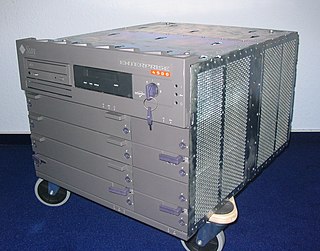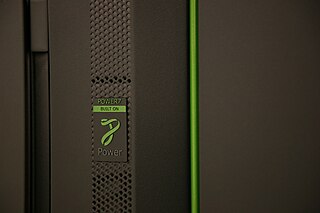
Silicon Graphics, Inc. was an American high-performance computing manufacturer, producing computer hardware and software. Founded in Mountain View, California in November 1981 by James Clark, its initial market was 3D graphics computer workstations, but its products, strategies and market positions developed significantly over time.
The 88000 is a RISC instruction set architecture developed by Motorola during the 1980s. The MC88100 arrived on the market in 1988, some two years after the competing SPARC and MIPS. Due to the late start and extensive delays releasing the second-generation MC88110, the m88k achieved very limited success outside of the MVME platform and embedded controller environments. When Motorola joined the AIM alliance in 1991 to develop the PowerPC, further development of the 88000 ended.

A workstation is a special computer designed for technical or scientific applications. Intended primarily to be used by a single user, they are commonly connected to a local area network and run multi-user operating systems. The term workstation has been used loosely to refer to everything from a mainframe computer terminal to a PC connected to a network, but the most common form refers to the class of hardware offered by several current and defunct companies such as Sun Microsystems, Silicon Graphics, Apollo Computer, DEC, HP, NeXT, and IBM which powered the 3D computer graphics revolution of the late 1990s.
Cray Inc., a subsidiary of Hewlett Packard Enterprise, is an American supercomputer manufacturer headquartered in Seattle, Washington. It also manufactures systems for data storage and analytics. Several Cray supercomputer systems are listed in the TOP500, which ranks the most powerful supercomputers in the world.
Alliant Computer Systems Corporation was a computer company that designed and manufactured parallel computing systems. Together with Pyramid Technology and Sequent Computer Systems, Alliant's machines pioneered the symmetric multiprocessing market. One of the more successful companies in the group, over 650 Alliant systems were produced over their lifetime. The company was hit by a series of financial problems and went bankrupt in 1992.

Sun Enterprise is a range of UNIX server computers produced by Sun Microsystems from 1996 to 2001. The line was launched as the Sun Ultra Enterprise series; the Ultra prefix was dropped around 1998. These systems are based on the 64-bit UltraSPARC microprocessor architecture and related to the contemporary Ultra series of computer workstations. Like the Ultra series, they run Solaris. Various models, from single-processor entry-level servers to large high-end multiprocessor servers were produced. The Enterprise brand was phased out in favor of the Sun Fire model line from 2001 onwards.

Amdahl Corporation was an information technology company which specialized in IBM mainframe-compatible computer products, some of which were regarded as supercomputers competing with those from Cray Research. Founded in 1970 by Gene Amdahl, a former IBM computer engineer best known as chief architect of System/360, it has been a wholly owned subsidiary of Fujitsu since 1997. The company was located in Sunnyvale, California.
Minisupercomputers constituted a short-lived class of computers that emerged in the mid-1980s, characterized by the combination of vector processing and small-scale multiprocessing. As scientific computing using vector processors became more popular, the need for lower-cost systems that might be used at the departmental level instead of the corporate level created an opportunity for new computer vendors to enter the market. As a generalization, the price targets for these smaller computers were one-tenth of the larger supercomputers.

The SPARCstation, SPARCserver and SPARCcenter product lines are a series of SPARC-based computer workstations and servers in desktop, desk side (pedestal) and rack-based form factor configurations, that were developed and sold by Sun Microsystems.
Sun-4 is a series of Unix workstations and servers produced by Sun Microsystems, launched in 1987. The original Sun-4 series were VMEbus-based systems similar to the earlier Sun-3 series, but employing microprocessors based on Sun's own SPARC V7 RISC architecture in place of the 68k family processors of previous Sun models.
The Cray Superserver 6400, or CS6400, is a discontinued multiprocessor server computer system produced by Cray Research Superservers, Inc., a subsidiary of Cray Research, and launched in 1993. The CS6400 was also sold as the Amdahl SPARCsummit 6400E.
GemStone/S is computer software, an application framework that was first available for the programming language Smalltalk as an object database. It is proprietary commercial software.
Network Systems Corporation (NSC) was an early manufacturer of high-performance computer networking products. Founded in 1974, NSC produced hardware products that connected IBM and Control Data Corporation (CDC) mainframe computers to peripherals at remote locations. NSC also developed and commercialized the HYPERchannel networking system and protocol standards, adopted by Cray Research, Tektronix and others. In the late 1980s, NSC extended HYPERchannel to support the TCP/IP networking protocol and released a product allowing HYPERchannel devices to connect to the emerging Internet.
The Cray S-MP was a multiprocessor server computer sold by Cray Research from 1992 to 1993. It was based on the Sun SPARC microprocessor architecture and could be configured with up to eight 66 MHz BIT B5000 processors. Optionally, a Cray APP matrix co-processor cluster could be added to an S-MP system.
The Cray APP was a parallel computer sold by Cray Research from 1992 onwards. It was based on the Intel i860 microprocessor and could be configured with up to 84 processors. The design was based on "computational nodes" of 12 processors interconnected by a shared bus, with multiple nodes connected to each other, memory and I/O nodes via an 8×8 crossbar switch.

PERCS is IBM's answer to DARPA's High Productivity Computing Systems (HPCS) initiative. The program resulted in commercial development and deployment of the Power 775, a supercomputer design with extremely high performance ratios in fabric and memory bandwidth, as well as very high performance density and power efficiency.
Celerity Computing, Inc., was a publicly traded vendor of Unix-based minisupercomputers based in San Diego, California. Celerity Computing was founded in May 1983 by Steve Vallender, Nick Aneshansley and Andrew McCroklin. All were former employees of NCR Corporation.

C. Norman (Norm) Winningstad was an American engineer and businessman in the state of Oregon. A native of California, he served in the U.S. Navy during World War II before working at what is now Lawrence Berkeley National Laboratory. After moving north to Oregon, he started working for Tektronix before starting several companies in what became the Silicon Forest in the Portland metropolitan area. He founded or helped to found Floating Point Systems, Lattice Semiconductor, and Thrustmaster. Winningstad and his wife were also noted philanthropists in the Portland area, with a theater at the Portland Center for the Performing Arts named in his wife Dolores' honor.

POWER9 is a family of superscalar, multithreading, multi-core microprocessors produced by IBM, based on the Power ISA. It was announced in August 2016. The POWER9-based processors are being manufactured using a 14 nm FinFET process, in 12- and 24-core versions, for scale out and scale up applications, and possibly other variations, since the POWER9 architecture is open for licensing and modification by the OpenPOWER Foundation members.








